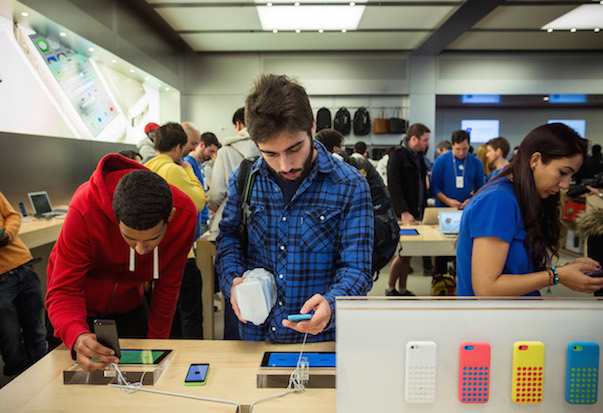If I had £1 for every press release I’ve received in the past fortnight telling me how to save money on the new iPhone 7, well…I could buy an iPhone 7.
But I wouldn’t because my existing phone (a Samsung something or other which cost about £200 a couple of years ago) works perfectly well.
The press releases landing in my inbox have been full of big ideas. ‘Best time to buy iPhone 7 is six weeks after launch,’ advises MoneySuperMarket, which can apparently see into the future.
‘Hold the handset! Don’t buy a new iPhone 7 until you find out this trick to save £100s,’ screams Gocompare.com. The price comparison site advises giving pay monthly contracts from networks a miss and, instead, buying the handset directly from Apple and taking out a SIM-only tariff with Virgin Media.
It’s worthy advice but there’s a better way to save the entire £599 to £919 iPhone 7 price tag in one easy money-saving tip: don’t buy it. £900 is the cost of a month’s rent, a new car or a fortnight’s holiday or…well, you get the picture. Basically, there are a lot of things you could spend the best part of a grand on that don’t involve replacing something that works perfectly fine.
But the iPhone fools won’t listen. They’re too busy ordering the latest upgrade which, I have concluded after reading several pages of reviews, is just a little bit better than the iPhone 6 which came out two years ago.
Not that the iPhone idiots received their shiny new overdraft-busting phones on time of course. Many were left deeply traumatised when, after pre-ordering handsets with O2, Three, EE and Vodafone, the mobile networks failed to come up with the goods on time.
Still it’s worth the wait, right? After all, the new iPhone 7 is not just better than the totally outdated (yet only two-years-old) iPhone 6, it’s blacker too. The iPhone 7 and 7 Plus both come in new ‘jet black’, a handy option if your existing black phone simply isn’t black enough.
Another ‘improvement’ is Apple’s controversial decision to ditch the iPhone headphone socket. The move has met with mixed views from iPhone fans with those in favour adopting the hashtag #courage to salute Apple’s bold stance.
What’s ‘courageous’ about a multi-billion pound outfit slightly altering the design of a gadget devotees will buy anyway is totally lost on me.
iPhone users now have the choice of using ‘Lightning earpods’ which come with the phone and plug into the charging port (which means you can’t charge your phone and listen to music at the same time), or sticking fancy new wireless ‘Airpods’ in their ears.
You’d think the Airpods would be included when you’re spending the equivalent of a month’s mortgage payment on a phone, wouldn’t you? Well, think again. They’re £159, bringing the total cost of buying the 256GB iPhone 7 Plus to a wallet-busting £1,078.
Another expense for Apple obsessives is insurance in case they break or lose their new toy, or if they put it down long enough for it to be swiped by an eagle-eyed thief. GoCompare suggests buying a specialist mobile phone insurance policy, adding your phone to your home insurance, or checking whether your phone is covered by your packaged bank account perks.
Well, at least your phone will work after spending all this money. Or will it? The most publicised fault with the iPhone 7 so far is a strange hissing sound. This follows the iPhone 6 which was prone to bending in trouser pockets and the iPhone 4 antenna which cut off the phone signal if you held your phone in the ‘wrong’ position.
As you might have guessed I’m not a big Apple fan. As a personal finance journalist, people often ask for my best money saving tip to which I always reply ‘stop spending’. This involves not splashing out hundreds of pounds on a new phone when your existing one works just fine. Those who do are paying a high price just to be really, really cool.
Emma Lunn is a freelance personal finance journalist






Comments